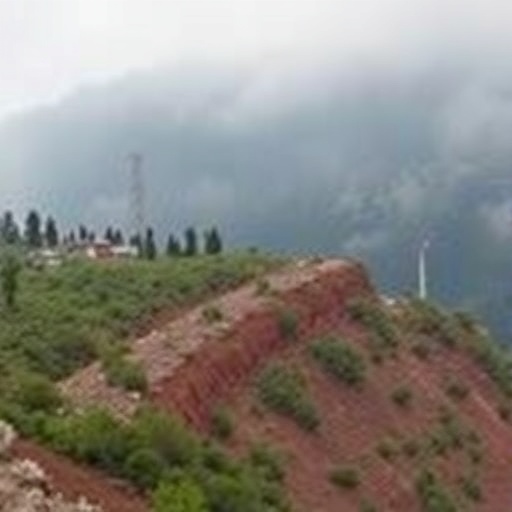In the face of the escalating impacts of climate change, the urgency for innovative solutions in environmental monitoring and disaster preparedness has never been greater. Among the most pressing challenges is the increased frequency and severity of shallow landslides, which can be devastating to both infrastructure and ecosystems. Recent advancements in Internet of Things (IoT) technology have opened up new avenues for early detection of these landslides, presenting a promising approach to mitigate their devastating effects. According to the pioneering study by Hofmann, Berger, and Wimmer, published in Commun Earth Environ, this technology has the potential to revolutionize how we monitor changes in our environment.
Shallow landslides, often triggered by heavy rainfall or rapid snowmelt, pose significant risks to mountainous and hilly regions. These landslides can occur with little warning, often resulting in catastrophic damage to properties, farmland, and even loss of life. Traditional methods of monitoring geological changes rely heavily on manual observations and infrequent assessments, leading to delays in detecting the onset of potential landslides. However, the integration of IoT technology emerges as a game-changer, enabling real-time monitoring of environmental conditions.
The study emphasizes that IoT technology can be deployed to collect a vast array of environmental data, including soil moisture levels, rainfall patterns, and seismic activity. By using a network of interconnected sensors, researchers can continuously gather this crucial data. These sensors can relay information to cloud-based data analytics platforms, creating a centralized system that allows for the rapid processing of information. With machine learning algorithms, data trends can be analyzed to predict the likelihood of a landslide occurrence based on historical and current data.
One of the most notable advantages of IoT technology is its ability to operate in real-time, providing immediate feedback on environmental conditions. For instance, soil moisture sensors can instantly alert authorities when saturation levels reach a critical threshold, indicating an elevated risk of landslides. This enables local governments and emergency services to activate contingency plans, perform necessary evacuations, or implement proactive measures to mitigate damage. The speed of response can be the difference between catastrophic outcomes and saved lives, highlighting the urgency of deploying such technology in vulnerable regions globally.
Furthermore, the authors discuss the modular nature of IoT systems, ensuring that they can be tailored to specific geographic and climatic conditions. For example, the sensors can be strategically placed in areas identified as high-risk, allowing for targeted monitoring. This flexibility allows researchers to adapt their approach based on local terrain, vegetation, and weather patterns, creating a customized solution that maximizes the effectiveness of the monitoring efforts.
In addition to immediate alerts, IoT technology offers comprehensive data analytics that can be vital for long-term disaster preparedness. By examining the patterns of landslide occurrences over time, scientists and policymakers can gain a deeper understanding of how climate change is reshaping geological stability. This understanding can inform better land-use planning, identify areas that may require reforestation, or dictate the development of new infrastructure projects with landslide risks in mind.
Moreover, the financial implications of implementing IoT technology for landslide monitoring are significant. While upfront costs may be a consideration, the potential savings yielded from preventing infrastructure damage and loss of life can far outweigh the initial investment. Communities that suffer repeated landslides often face substantial economic burdens, so proactive measures that leverage technology can provide both immediate and long-term fiscal benefits.
However, the transition to IoT-based monitoring systems is not without its challenges. The authors highlight the need for interdisciplinary collaboration among geologists, data scientists, and engineers to ensure the systems are robust, reliable, and user-friendly. Additionally, there are considerations regarding data privacy and cybersecurity, especially when information is shared across networks. Safeguarding this data is crucial, as any breaches could undermine public trust and the effectiveness of the monitoring systems.
Despite the promising advances in this field, the successful implementation of IoT technology for landslide detection also requires significant public awareness and education. Communities need to understand how these systems work, their benefits, and the actions that should follow alert notifications. Engaging with local populations to demystify the technology can foster cooperation and preparedness in the event of a landslide, creating a community-based approach to disaster management.
The research conducted by Hofmann, Berger, and Wimmer stands as a pivotal step in harnessing technology to confront natural disasters exacerbated by climate change. With continued innovation and collaboration, we can expect that more advanced and reliable systems will emerge. The study contributes to a growing body of literature that advocates for technology-driven solutions to environmental challenges, paving the way for a safer and more resilient future.
Overall, the future of environmental monitoring and landslide prediction looks promising with the integration of IoT technology. As we continue to face the pressures of climate change, embracing these advancements could ensure we are better prepared for the challenges that lie ahead. Successful applications of this technology cannot only prevent disasters but can also aid us in understanding the complex relationship between our climate and geological stability. The intersection of technology, environmental science, and disaster risk management will prove crucial in navigating the new realities we face in a changing world.
As research and development in this field progress, we can anticipate not only improved methods for landslide detection but also the establishment of a framework for utilizing IoT technology across various environmental domains. The implications extend beyond landslide detection, marking a significant advancement in our ability to monitor and respond to multiple natural disasters, ensuring communities can adapt and thrive in the face of climate change.
Subject of Research: Early detection of climate change-induced shallow landslides with IoT technology
Article Title: Early detection of climate change-induced shallow landslides with IoT-technology
Article References: Hofmann, R., Berger, S. & Wimmer, L. Early detection of climate change-induced shallow landslides with IoT-technology. Commun Earth Environ 6, 695 (2025). https://doi.org/10.1038/s43247-025-02668-5
Image Credits: AI Generated
DOI: 10.1038/s43247-025-02668-5
Keywords: IoT technology, shallow landslides, climate change, early detection, environmental monitoring, machine learning, disaster preparedness.




